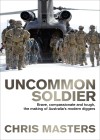Uncommon Soldier: The Story of the Making of Today’s Diggers
Written by: Chris Masters,
Allen & Unwin, 2012,
ISBN 9781741759716, 400pp
Reviewed by: Iain Henry, Australian National University
Australia’s military involvement in Afghanistan now represents the longest conflict in our nation’s history, yet the tactical and operational details of that involvement are often denied to the public. In May 2013, Defence allowed operational commanders to brief the media on a series of engagements that took place in the Shah Wali Kot area of Tarin Kowt. There is little doubt that Australian soldiers performed admirably — the valour of one was recognised by the award of the Victoria Cross. However, from one perspective the briefing was no cause for pride — it had taken almost three years for the Australian public to learn significant details of these events, which took place in June 2010. Almost a century on from the horrors of Gallipoli, our grandparents and great-grandparents received more detailed and contemporaneous reporting. In this context, Chris Masters’ Uncommon Soldier can make an important contribution to Australia’s understanding of the military deployment in Afghanistan. Best described as a series of short stories told from the tactical perspective, it provides much-needed colour to the official, anodyne Defence narrative of the conflict.
Masters contextualises these stories by first examining the training processes for Australian soldiers — both officers and other ranks. He identifies and explains many of the transformative elements of military training, including the indoctrination process of the fostering of shared expectations and identity. This section of the book is perhaps the best account of Australian military training in print today.
The main effort of the book — an explanation of modern soldiering in an ancient society — will enlighten those readers unfamiliar with the Army and its operations in Afghanistan. In this sense, the book is a valuable contribution to public awareness, making accounts of heroism, bravery and sacrifice accessible to the average reader. The narrative is frank and uncensored, replete with dark humour, expletives and an atmosphere of suspense. At the other end of the spectrum, Masters is sensitive and respectful in describing Australian casualties — the account of Sapper Darren Smith’s death is particularly moving.
For those looking for more than this, the book might disappoint. The strategic context of Australia’s involvement is left unassessed, and the adaptability and efficiency of Australia’s broader Defence machinery is often questioned, but not seriously examined. Most frustratingly, given his authoritative position as one of Australia’s relatively few foreign correspondents, Masters skirts around the issue of media reporting on Australia’s commitment, never quite offering a satisfactory explanation as to why so little detail emerges from such a protracted conflict. While he notes that ‘the persistent excuse that operational security counted more than transparency had become less convincing by the year’, he does not fully analyse why restrictive media practices and hostile attitudes persist, nor why Australian practices differ so markedly from those of our allies.
Even the structure of Masters’ narrative hints at the difficulties he may have encountered in writing the book: many of the short stories revolve around engagements that resulted in soldiers receiving gallantry awards. If even a journalist has to resort to the Australia Day and Queen’s Birthday Honour Lists as primary sources, then the time has come to re-examine the validity of the ‘operational secrecy’ catch-cry. For reasons left unexplained to the reader, Masters exonerates those senior ADF leaders responsible for managing such issues, instead praising their eventual willingness to grant him a greater level of access.
Another critique is that, at times, the book has a very hagiographic feel. The introductory chapter describes Masters’ own struggle to resolve the ANZAC myth with a ‘concern about a stretching of the truth’ (p. xvii). While he ends the chapter by concluding that Australians are indeed ‘uncommon soldiers’, it is unclear precisely what quality or attribute warrants this distinction. It is certainly possible, without diminishing the praiseworthy conduct of many individual Australian soldiers in Afghanistan, to subject Australia’s involvement to a more rigorous and objective analysis.
While some readers will find that this book raises more questions than it answers, the average reader is likely to learn much about Australia’s deployment to Afghanistan. Masters has performed a significant service in making these personal, confronting and a thentic stories so easily accessible, and on this basis the book is both a timely and important contribution.

